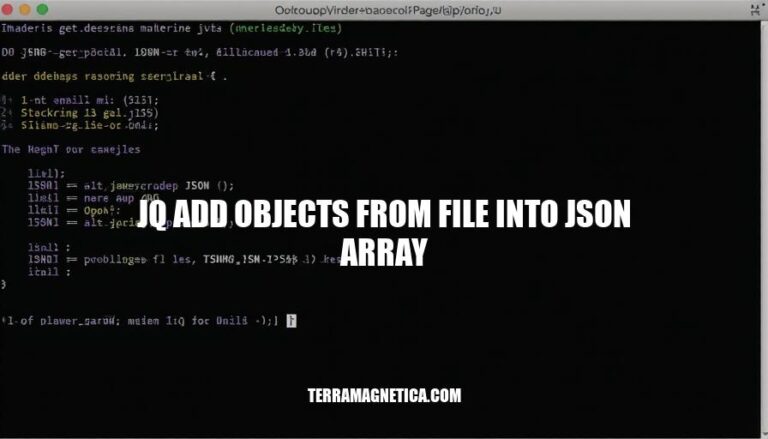


Using jq to add objects from a file into a JSON array is a powerful technique for managing and manipulating JSON data. This operation is crucial for tasks such as merging data from multiple sources, updating configuration files, and automating data processing workflows. Common use cases include aggregating logs, combining API responses, and updating datasets in a structured and efficient manner.
jq is a lightweight, command-line JSON processor that allows you to filter, map, and transform structured data with ease. It uses a simple, declarative language to query, read, update, and delete JSON elements without needing to write loops or iterate through data structures.
Capabilities:
Preferred Tool:
Adding Objects to a JSON Array:
To add objects from a file into a JSON array, you can use the --argjson flag to pass a JSON object as a variable to a jq filter. For example:
POST=$(<post.json)
jq --argjson p "$POST" '.posts += [$p]' blog.json
This command reads the content of post.json into the POST variable, then uses jq to append this object to the posts array in blog.json.
Here are the basic syntax and commands in jq to add objects from a file into a JSON array, along with examples:
Reading JSON from a file and adding it to an array:
jq '.array_name += [inputs]' target_file.json source_file.json
Using --argjson to pass JSON objects as variables:
jq --argjson var_name 'json_object' '.array_name += [$var_name]' target_file.json
Suppose you have post.json:
{
"author": "Jane Smith",
"published": "2023-10-11",
"content": "This is a short example blog post."
}
And blog.json:
{
"title": "Baeldung",
"author": "John Doe",
"domain": "baeldung.com",
"posts": []
}
To add the object from post.json to the posts array in blog.json:
jq --argjson p "$(cat post.json)" '.posts += [$p]' blog.json
If you have multiple JSON files like post-1.json, post-2.json, etc., you can use a loop in a shell script:
#!/bin/bash
blog=$(<blog.json)
for json in post-*.json; do
blog=$(echo "$blog" | jq --argjson p "$(cat $json)" '.posts += [$p]')
done
echo "$blog"
inputs to Add ObjectsIf you want to add objects from source.json to an array in target.json:
jq '.array_name += [inputs]' target.json source.json
These commands and examples should help you get started with adding objects to JSON arrays using jq!
Here’s a step-by-step example:
Create blog.json:
{
"title": "Baeldung",
"author": "John Doe",
"domain": "baeldung.com",
"posts": []
}
Create post.json:
{
"author": "Jane Smith",
"published": "2023-10-11",
"content": "This is a short example blog post."
}
Use jq to add the object from post.json to the posts array in blog.json:
jq --argjson p "$(cat post.json)" '.posts += [$p]' blog.json > updated_blog.json
Result in updated_blog.json:
{
"title": "Baeldung",
"author": "John Doe",
"domain": "baeldung.com",
"posts": [
{
"author": "Jane Smith",
"published": "2023-10-11",
"content": "This is a short example blog post."
}
]
}
This command reads the content of post.json, assigns it to the variable p, and appends it to the posts array in blog.json.
Here are some methods for adding objects from multiple files into a JSON array using jq, along with examples and best practices:
--argjsonThis method involves reading the content of each JSON file and passing it as a variable to jq.
# Read content of post.json into a variable
POST=$(<post.json)
# Add the object from post.json to the posts array in blog.json
jq --argjson p "$POST" '.posts += [$p]' blog.json
inputs and --slurpThis method reads multiple JSON files and combines them into an array.
# Combine objects from multiple files into a single array
jq -s '[.[]]' post-*.json
For managing multiple JSON files, a shell script can automate the process.
#!/bin/bash
# Read the initial blog.json
blog=$(<blog.json)
# Loop through each post file and add its content to the posts array
for json in post-*.json; do
blog=$(echo "$blog" | jq --argjson p "$(cat $json)" '.posts += [$p]')
done
# Output the final JSON
echo "$blog"
These methods and practices should help you efficiently manage and manipulate JSON arrays using jq.
Issue: Multiple Arrays Created
jq --slurpfile to wrap contents in an array and append using inputs:jq '. + [inputs]' output.json File_1.json
Issue: Overwriting Existing Data
--argjson to pass JSON objects as variables:POST=$(<post.json)
jq --argjson p "$POST" '.posts += [$p]' blog.json
Issue: Handling Duplicates
| unique to remove duplicates:jq '. + [inputs] | unique' output.json File_1.json
Issue: Inconsistent Data Formats
jq --argjson p "$(jq . post.json)" '.posts += [$p]' blog.json
Issue: Missing Fields
map_values to ensure all objects have required fields:jq 'map_values(. + {required_field: "default_value"})' file.json
These solutions should help address common issues when using jq to add objects from a file into a JSON array.
Using jq to add objects from a file into a JSON array is a powerful technique for manipulating JSON data.
--slurpfile to wrap contents in an array and append using inputs--argjson to avoid overwriting existing data| unique to the commandjq . on the filemap_valuesThese methods and practices can be used together to efficiently manage and manipulate JSON arrays.
Futher exploration of jq is encouraged, as it offers many more features and capabilities for working with JSON data. With practice and experience, users can unlock the full potential of jq and become proficient in manipulating JSON arrays and objects.